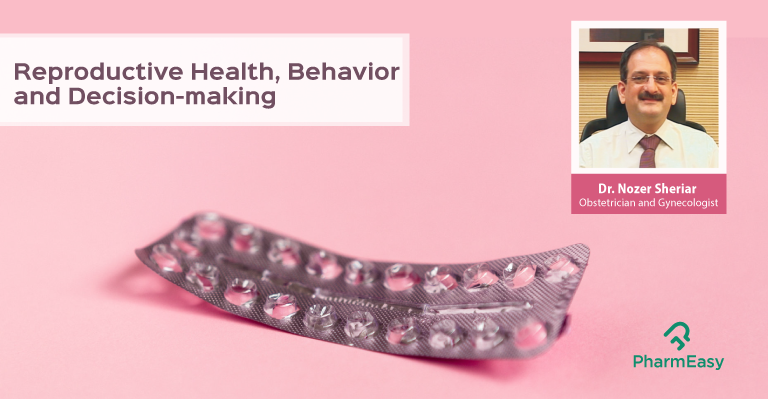Customized Contraception In Modern Medicine By Dr. Nozer Sheriar
By PharmEasy Medical Board +2
more
Last updated: Oct 25, 2024 Published on: Sep 11, 2017
Click to rate this article!
Modern contraception, developed in the second half of the 20th Century, is justifiably considered one of the greatest advances in medicine and rates among the greatest innovations in human history. It gives couples the means to avoid an unplanned conception so that every pregnancy that occurs is a wanted one.
Contraceptive Methods – Range and Choices
- We are now fortunate to have the entire range of contraceptives available globally with implants soon to be introduced. This has truly made possible the cafeteria approach allowing women a choice for their individual situation and preference. While permanent contraception – tubectomy or vasectomy still remains the dominant method practised in India, there is now a concerted effort to shift to temporary and spacing methods.
- Of these the most effective methods (less than 2% failure) are intrauterine contraceptives (IUDs) – both medicated and hormonal and hormonal contraceptives – oral pills, vaginal rings, transdermal patches, injectables and implants. These are followed ineffectiveness by conventional contraceptives (8-12% failure) – male and female condoms and spermicides, with these having the additional benefit of preventing reproductive tract and sexually transmitted infections. Behavioural contraception (20-25% failure) p- safe period and withdrawal, though the least effective method has to be acknowledged since it is widely practised.
Contraception in Special Situations
- The dictum stating that “most contraceptives are generally safe, it is some women that are dangerous” is addressed by the WHO Medical Eligibility Criteria. These guidelines are based on scientific evidence and expert deliberations and underline the safety of contraceptive use in most clinical situations.
- Emergency contraception (EC) is particularly important at times of unexpected risk of pregnancy due to unprotected sex or possible failure of a method. Initially achieved with two doses of combined estrogen-progestogen contraceptive pills (COC), it is now more effective with the levonorgestrel pill or low dose mifepristone used within 72 hours. The medicated copper IUD is effective for EC even up to 5 days.
- The progestogen-only pill (POP) is safe for use post-delivery for lactating women. Started after 6 weeks it is safe for both mother and child and does not impact the quantity or quality of milk production.
- The levonorgestrel intrauterine system (LNG IUS) is a progestogen releasing IUD. Besides being highly effective, it reduced blood loss during menstruation by up to 90%, greatly benefiting women’s health. Young people need special treatment in a separate category. Every available contraceptive is safe for use by youth. However, there has to be a youth-friendly, nonjudgmental approach towards information provision and contraceptive availability if they are to be protected and cared for. Information can be provided by innovative outreach using the internet and social media and contraceptive distribution carried out by youth-friendly clinics, slot machines and kiosks and online distribution.
Public Health Initiatives
- The most recent development in long-acting reversible contraception (LARC) is the increasing use of the postpartum IUD (PPIUD). Inserted immediately after the delivery of the placenta it precludes the need for an additional procedure, encouraging high acceptance rates. Being increasingly used in the public health system, this combined with the move to institutional deliveries has great potential for spacing pregnancies.
- After years of being available for use in India, injectable contraception with progestogen that needs to be administered every 3 months are finally available in the public sector. Injectables offer women confidentiality, are highly effective and the cessation of menses in a majority leads to improved haemoglobin status. At last, women seeking to benefits of injectables in the public sector will have the access long enjoyed by their counterparts in the private sector.
Structured Contraceptive Counselling
- A study published in the Journal of Obstetrics and Gynecology of India (JOGI) in 2014 with 825 women in 36 centres offered great insights on the value of a structured, standardised counselling protocol followed by all practitioners. Significant reductions were observed in the proportion of women who were indecisive from 31.5 % to just 3.6% and those opting for the less effective conventional methods from 24.6 % to 6.8%. The study concluded that women were very receptive to the structured counselling approach because it accorded them greater autonomy in terms of choice and confidentiality.
- The basket of varied contraceptive choices, structured, respectful and inclusive counselling and the woman’s participation in making the final decision make it now possible to customise contraceptive methods to suit the biological requirements and personal preferences of each individual.
Addressing Concerns Regarding Health Risks of Contraception
- While Oral Contraceptive (OC) pills are associated with concerns of ischemic heart disease, stroke and thromboembolism, these are mainly associated with a small at-risk population of heavy smokers, severe uncontrolled hypertension or the rare condition of thrombophilia. These are balanced by the non -contraceptive menstrual and cosmetic benefits, protection from endometriosis and ovarian cysts.
- Nausea and vomiting may be associated with Emergency Contraceptive (EC) pills and headache and dizziness are also reported. Some women may experience spotting or irregular uterine bleeding particularly when repeated courses are taken. While none of these is cause for medical concern women must be advised to more reliable methods.
- For medicated copper Intra-Uterine Devices (IUDs) side effects albeit rare include bleeding and pain with higher chances of pelvic infection. These are not a problem with the LNG IUS which are instead associated with disturbed or absent menses that only require counselling and reassurance.
The Issue of Products for Sanitary Hygiene
- Menstrual hygiene is vital for women’s health and the primary prevention for RTIs and STIs. Approximately 15% of women use modern sanitary hygiene such as napkins and tampons. The others use and reuse cloth which they are often unable to wash and dry because of embarrassment and shame.
- This should have been the time to take a bold step for women’s health and work to increase the coverage of women with modern sanitary hygiene products. While the development of low-cost products would be the goal, an exemption or a least a significant reduction in tax levied on these products would have to be benefitted women greatly.
A Government Tax on Sanitary Products
The 12% Goods and Service Tax (GST) imposed on sanitary products makes them a luxury item which these definitely are not. There is an urgent need for the government to reconsider this tax so as to treat sanitary napkins as a basic necessity for every woman irrespective of their class or background. It is of public health importance in providing better hygiene, preventing infections and promoting reproductive health and fertility. If there was one deserving issue for advocacy of women’s health to lobby the government, this is probably it.
About the Author

Dr. Nozer Sheriar is Consultant Obstetrician and Gynecologist, Breach Candy, Hinduja Healthcare and Holy Family Hospitals. He was Secretary General and Medical Termination of Pregnancy (MTP) Chair, Federation of Obstetric and Gynecological Societies of India (FOGSI) and Past President, Mumbai Obstetric and Gynecological Society.
Disclaimer: The information provided here is for educational/awareness purposes only and is not intended to be a substitute for medical treatment by a healthcare professional and should not be relied upon to diagnose or treat any medical condition. The reader should consult a registered medical practitioner to determine the appropriateness of the information and before consuming any medication. PharmEasy does not provide any guarantee or warranty (express or implied) regarding the accuracy, adequacy, completeness, legality, reliability or usefulness of the information; and disclaims any liability arising thereof.
Links and product recommendations in the information provided here are advertisements of third-party products available on the website. PharmEasy does not make any representation on the accuracy or suitability of such products/services. Advertisements do not influence the editorial decisions or content. The information in this blog is subject to change without notice. The authors and administrators reserve the right to modify, add, or remove content without notification. It is your responsibility to review this disclaimer regularly for any changes.
 1
1 

























Comments